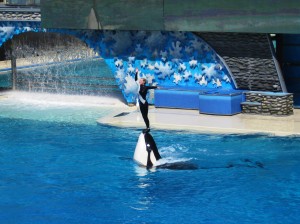My image was inspired by Abigail’s post about competitive horseracing and focuses on the use of animals for entertainment. Like Abigail, I wanted to pick an image that represents a human-animal relationship in which the human is in control so I chose a picture of a Sea World trainer performing tricks with her orca. At first glance my image seems very innocent because it shows a happy trainer standing on the nose of an orca entertaining a crowd, but when you analyze this image it becomes clear that the trainers that interact with their orcas have more of a master-slave relationship rather than a performer-assistant rapport.
The first thing that I noticed in my image is that the trainer is on top of the whale, which insinuates that she has dominance over the animal. This subtle feature of the image signifies that the trainer has control over the whale’s actions and that the orca is submitting to her. When I first saw a Sea World show I didn’t think much of this relationship because I figured doing tricks for a crowd was more rewarding than swimming aimlessly in the wild, but after reading the Walker text I’ve become disenchanted with this practice. In the Walker text the author compares horse breeding to the practice of slavery by pointing out that in each case the victim is being held captive to serve a single purpose and then is discarded when that purpose has been fulfilled (Regan 185). In the picture I chose the orca is also used for a single practice, which is entertainment, and then is sent away once it becomes too old to serve that purpose. The CNN Documentary film Blackfish provides more insight about this practice by explaining that the orcas that are used in SeaWorld shows are usually bred in captivity for the sole purpose of growing up to be a part of the SeaWorld shows (Blackfish). In “Am I Blue” Walker would make a similar argument by insisting that Blue is being used for the sole purpose of creating a desirable offspring that the breeders can then sell for a high price. In both scenarios the animal in question is being exploited for the economic benefit of others and is no longer seen as valuable once its duties have been performed.
Using whales for entertainment may not seem like a horrible thing but when you learn the facts, like that they spend their whole lives in a small aquatic cage and perform several hours a day, you realize that they are essentially slaves that are used for our amusement. The whales that are being used in these shows are no different from many horses that are used for breeding in the sense that they are taken from the wild against their will and are forced to perform a task for the benefit of others.
Another reading that I had of this image was that it seemed to really embody the dualism that Berger talks about in the reading. Here is an organization whose mission statement is to, “Advance the global understanding of killer whales, and educate and inspire conversation efforts to protect those in the wild,” yet the way that they’re “inspiring conservation efforts” is putting animals into bodies of water that are way smaller than the ones found in their natural habitat (Blue World Project). I think there is an incredible amount of irony in this practice because if you were truly dedicated to educating and conserving you would teach people about whales in their natural habitat and not take them from their home and place them in an artificial sea. I understand that SeaWorld is a business that uses their shows to educate as well as entertain, but I think that those who train and use whales in shows are failing to see the psychological ramifications that their actions are having on the wellbeing of these whales.
Work Cited
1. Berger, John. About Looking. New York: Pantheon, 1980. Print.
2.Blackfish. Dir. Gabriela Cowperthwaite. Magnolia Pictures, 2013. DVD.
3. “Blue World Project.” Blue World Project. Sea World Parks and Entertainment Inc., 5 Apr. 2014. Web. 14 Sept. 2014.
4. Regan, Tom, and Andrew Linzey. Other Nations: Animals in Modern Literature. Waco, TX: Baylor UP, 2010. Print.

Why do you think people are so passionate about whales and dolphins not being held in captivity but there is no controversy about having a personal aquarium? Do you think it has to do with the intelligence levels of whales and dolphins?
That’s a great question, Sonia.
Thank you for the question Sonia. One of the arguments that is brought up in the CNN documentary Blackfish is that keeping dolphins and whales captive is detrimental to their health and well being because, as you suggested, they have such high levels of intelligence. Whales and dolphins can actually become depressed from being held captive where as a fish in a personal aquarium doesn’t realize that they are living in captivity because they are not highly intelligent. The arguments against captivity are usually based on the idea that the creatures in question are too sentient to be kept in close quarters and therefore deserve to be free. If you want to know more about this debate I definitely recommend viewing Blackfish as it gives a great insight into this issue.